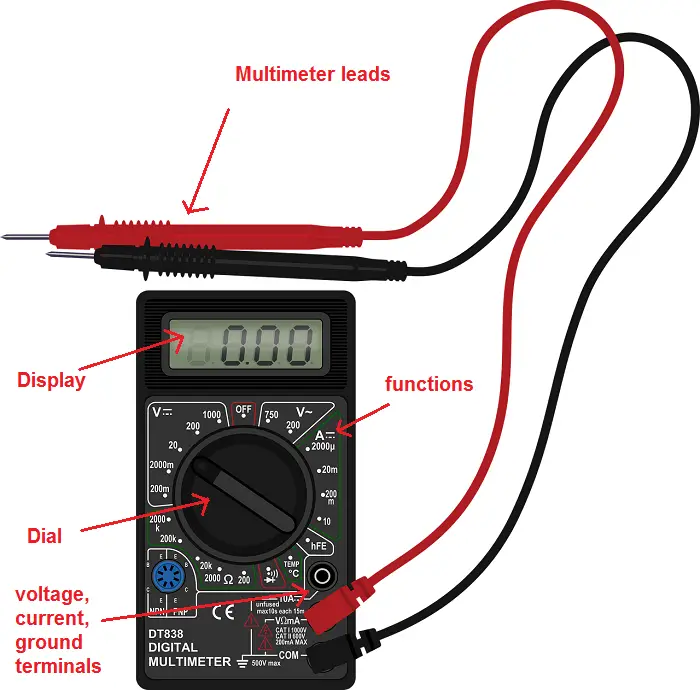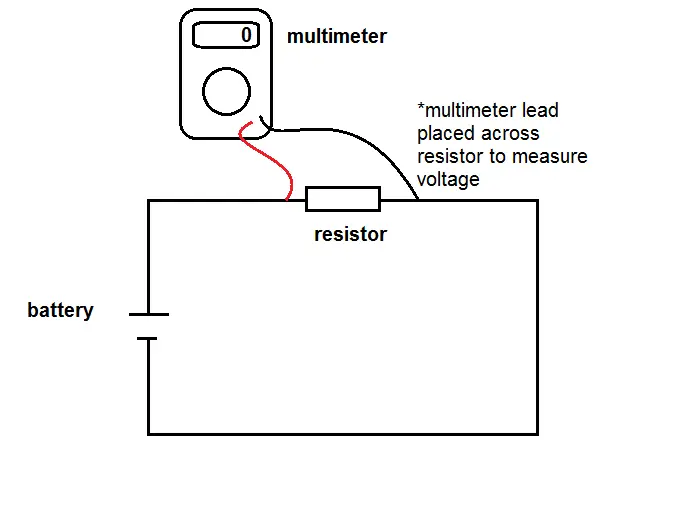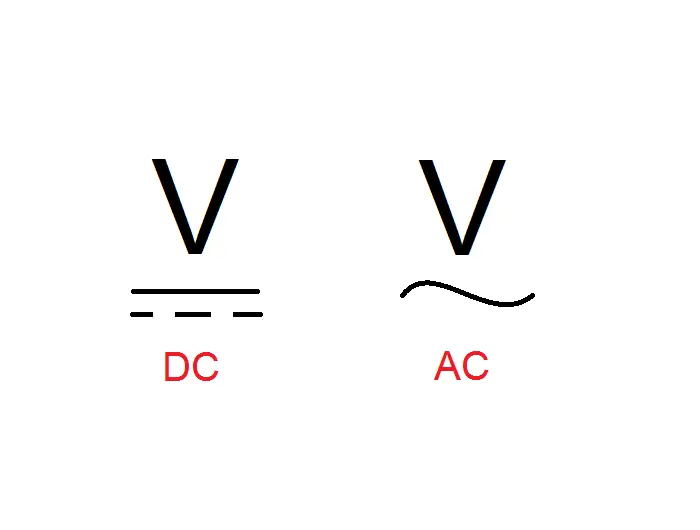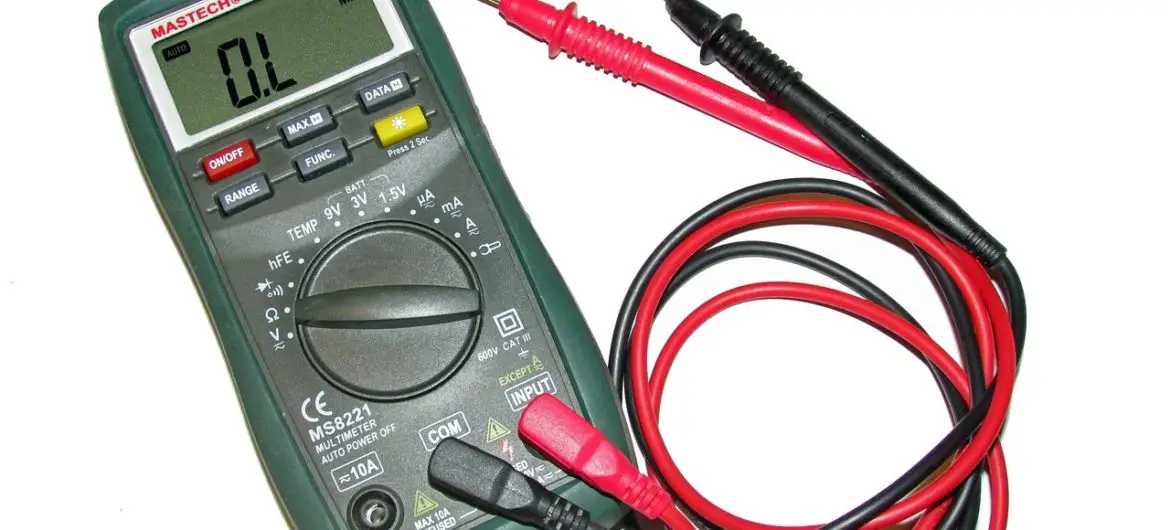Sooner or later you are going to encounter problems in life.
Your car tyre might go flat, you might have split wine on your very white carpet, or you might have torn your favorite t-shirt, etc.
But, fear not, there is good news! Lucky for you and me, there are tools that exist to help us solve and rectify these kinds of problems.
This is no different in the electrical and electronic world. It’s inevitable that you are going to encounter problems.
So, having tools to help analyse these problems is a necessity to ensure that you aren’t stuck in the mud.
One of the most common and widely used tools for fault finding, and analysis of circuits is the Digital Multimeter.
But, what is the use of a digital multimeter? Digital multimeters are electronic measuring instruments that are used for fault finding, analysis, and diagnosis of electrical and electronic circuits. They have the ability to measure electrical quantities such as voltage, current, and resistance.
However, there is more to digital multimeters than meets the eye which shall be discussed in detail in this article.
Closer look at a digital multimeter?
The digital multimeter is a variety (digital version) of the Multimeter.
While the digital version of the multimeter is the most commonly used nowadays, it has come a long way from its humble analog beginnings.
A brief history of the analog multimeter
Analog multimeters, or earlier versions first showed up on the electrical scene in 1820. Back then they were known as Galvanometers.
They were limited to only detecting electrical current, and resembled a compass which had a needle that moved depending on the amount of current.
Fast forward 100 years, the first version of the modern day multimeter was created thanks to Donald Macadie.
His multimeter wasn’t limited to just measuring current, but could measure voltage and resistance as well.
How analog multimeters work
The fundamental workings of an analog multimeter is based around something known as a moving coil meter.
Measuring voltage, current or resistance, depends on the configuration of some precision shunt resistors (either in series or parallel).
While there are many versions of the analog multimeter, each having its own method of measuring voltage, current and resistance, the moving coil meter is the most widely used method.
Analog multimeters have a needle (that is connected to a coil meter) and is deflected according to the amount of current that the coil meter is subject to.
This comes to fundamental science, and the fact that current flowing through a wire generates a magnetic field.
This is the basics of how the analog multimeter measures current. As mentioned earlier, to measure other variables such as voltage and resistance, additional components will need to be added (such as high precision shunt resistors).
Brief history of the digital multimeter?
Unfortunately, with the advancement of technology, analog devices were being replaced by digital counterparts and this was no different for multimeters.
This was possible with the rise of Semiconductors. A solid state voltmeter was in the development phase as early as the 1950s.
However, it wasn’t until 1977 when the Fluke 8020A became the first readily available digital multimeter.
Over the years, with the cost of manufacturing decreasing, the digital multimeter started to make its way to the forefront and was the go to multimeter.
The Fluke 8020B sold over 1 million units by the late 1980s.
How a digital multimeter works
The most noticable difference between an analog and digital multimeter is the display.
While an analog multimeter uses a needle that physically moves, the digital version uses a Liquid Crystal Display (LCD) that displays values of voltage, current and resistance.

Also, there is no moving coil meter in a digital multimeter.
They use integrated circuits such as operational amplifiers, Analog to Digital Converters (ADC), Digital to Analog Converters (DAC), Microcontrollers, and/or Microprocessors.
Below are the sequence of steps that occur within a digital multimeter when it is subject to a current, voltage, resistance, etc at its input;
- Input is converted to a DC voltage within the ADC range
- ADC converts DC voltage to a digital value
- This values is displayed on the LCD screen
The steps mentioned above are more common for measuring voltage. To measure current and resistance, the digital multimeter implements techniques similar to those used by its analog counterpart (using series and parallel shunt resistors).
To measure current, voltage is measured across a known resistor.
For resistance measurement, voltage is measured across a resistor via a known resistance from a stabilised voltage in the meter.
Digital multimeters come equipped with a Positive (red) and Negative (black) terminals where multimeter probes are connected to.
What is the main use of a digital multimeter
The digital multimeter is a very versatile tool and while it might have been restricted to a few functions in its earlier time, it has come a long way, and nowadays digital multimeters come packed with a myriad of functionalities
So to eliminate confusion, I shall go through and give a description of each function and its overall uses.
I shall break this section into two parts; functions of a digital multimeter and uses of digital multimeter in given applications using those particular functions.
Function #1 of a digital multimeter: Voltage
The first most basic function of the digital multimeter is to measure Voltage.
Voltage is one of the three basic building blocks of any electrical and electronic circuit (current and resistance being the other two).
Theory is only one half of the puzzle when building and designing a circuit.
When it comes to the practical part of building the circuit, knowing that the values of voltage you calculated for in the design process match the voltages in the circuit you built is essential to make sure you are on the right track.
That is why a digital multimeter comes equipped with a function of measuring voltage.
Voltage is the potential difference between two points in a circuit, so you will have to measure across a component or between two points in a circuit.
For example, if we had a simple circuit of a battery and resistor, and needed to measure the voltage of the resistor, you would place the multimeter probes across the resistor as seen below.

Function #2 of a digital multimeter: Current
Next of the three building blocks is Current.
Current can be defined by the flow of electrons within a conductive material.
Knowing that the right current is flowing in a circuit is essential to protecting components from damage.Every component has a specific current requirement to operate effectively.
If they are subject to currents above their maximum ratings for a given amount of time they can get damaged.
Also, on the other hand, if you do not supply the right amount of current, the component will not work.
So, knowing that the right amount of current is being supplied is an essential function a digital multimeter needs to have.
Unlike measuring voltage, current measurement needs to be done by placing the multimeter in series within a circuit.

Function #3 of a digital multimeter: Resistance
The last piece of the fundamental building blocks of electricity is Resistance.
A digital multimeter has the ability to measure resistances of any type of material (specifically conductors).
The main function of a digital multimeter resistance measurement is, well, to measure resistance of a component or circuit.
But, resistance measurement yields more than just that, it can tell us the condition of a circuit or component as well (some components resistance deteriorates over time, while others increase. Both these are unwanted scenarios)
Resistance plays a big role in circuits, as it can control the amount of current flowing; the higher the resistance the lower the current, and the lower the resistance, the higher the current.
Measuring the resistance is similar to voltage measurements and needs to be done across components or two points in a circuit.
Function #4 of a digital multimeter: Continuity
Imagine you needed to drive to a certain destination. To get from Point A, to Point B, you are going to need a continuous path (in this case road).
If there happens to be a hole in the road, or a tree is obstructing it, you will not be able to get to your final destination.
The same holds true for current moving through wires, and components in a circuit. It is going to need a continuous path to flow freely.
If a wire is cut in half, a component is not working, there is bad soldering, etc, this is going to prevent the flow of current.
Continuity is a function of a digital multimeter that lets you test the presence of a complete path between two points in a circuit.
Function #5 of a digital multimeter: Temperature
Digital multimeters now come with the added ability to measure Temperature.
Note, not all digital multimeters will be able to measure temperature. Multimeters that can measure temperature will come with a thermometer symbol on the dial. You can also check the manual of the multimeter.
This is a great benefit because, if you are someone who needs to measure the basics (voltage, current, resistance), as well as need to take temperature measurements, you will not need a separate device to do so.
You will have all the functions necessary in one convenient device.
The digital multimeter has the capability of providing temperatures in both Degrees Celsius and Degrees Farhanheit.
Depending on the need of the application, there are multiple varieties of probes available for temperature measurement.
Function #6 of a digital multimeter: Frequency
Frequency is a term used a lot in life.
It defines the number of times an event occurs within a set period of time.
For example, how many buses pass a bus station every hour.
In the electrical world current is divided into Direct Current (DC) and Alternating Current (AC).
Alternating currents are represented by a Sine wave which involves currents that vary in magnitude and polarity.
The frequency in the electrical world defines the number of times a sine wave of an alternating current repeats itself within a certain time period.
Circuits and electrical components are designed to operate at a certain fixed or variable frequency. If they are subject to different frequency values, the circuit will not operate as intended.
So, digital multimeters have a Frequency function to ensure all values are correct.
Function #7 of a digital multimeter: Capacitance
Voltage, current, and resistance form the basic building blocks of electrical and electronic circuits. However, there are many other factors that play a part in the overall working.
One of them is Capacitance.
Capacitance is defined as the capability of a component or device to store energy in the form of an electric field.
Now, just like a resistor is created specifically for resistance, a component known as a capacitor has the specific purpose of providing a specific value of capacitance in a circuit.
Digital multimeters can measure the capacitance of a capacitor (as well as other components).
Function #8 of a digital multimeter: Diode test
Finally we have the Diode test.
A diode is a two terminal, semiconducting device that only allows current to flow in one direction.
There are many different types of diodes which include; Light emitting diode, Zener, Shockley, PN junction, etc.
Below are some of the uses of diodes in electrical circuits:
- Rectifying voltage: rectifying AC voltage to DC
- Drawing signals from a supply
- Manipulating magnitude of a signal
- Mixing signals
The diode test function on a digital multimeter allows you to analyse a diode to ensure it is fully functional.
Here are some analysis of a diode after testing with a multimeter;
- A functional (forward-biased) diode should display a voltage ranging from 0.5 – 0.8 volts
- Multimeter will display infinite resistance (0L), when diode used as open switch
- A non-function diode will prevent flow from both directions. The multimeter will display infinite resistance (0L) for both directions
Uses of a digital multimeter
Now that we have gone through the different functions of the digital multimeter, let’s take a look at the uses of each function for particular applications.
There are many uses for each particular function, but rather than going through them all, to save you time, I shall name the most common ones.
Digital multimeter voltage function uses:
- Measure voltage drop across a component
- Measure voltage drop between two points in a circuit
- Measure voltage of a car battery, or batteries used in electronic devices
- Measuring voltage of electrical components (AC)
Digital multimeter current function uses:
- Measure current through a circuit (series and parallel)
- Measure startup or in-rush current
- Analyse power consumption of a circuit (how much current is being used by certain components)
Digital multimeter resistance function uses:
- Measure resistance of resistors
- Measure resistance of components, wires, overall circuit
- Check resistance of components to see if the faulty
Digital multimeter continuity function uses:
- Check if wire has continuous path
- Check for short circuits
- Check for open circuits
- Check if component damaged
Digital multimeter temperature function uses:
- Measure temperature of transformer
- Installation of heat pump – ensure temperature is right
- Food – measure temperature of meats, liquids, etc (using different probes)
- Measure temperature of an enclosed electrical/electronic system
Digital multimeter frequency function uses:
- Measure frequency of circuit – ensure it is within the operating range
- Measure frequency of AC motors
- Measure frequency of oscillating circuits
- Audio – ensure right frequencies are used
Digital multimeter capacitance function uses:
- Measure capacitance of capacitors
- Measure capacitance of wires, components, overall circuit
Digital multimeter diode function uses:
- Test functionality of diode
- Ensure diode is operating in right direction (forward bias)
Important factors of a digital multimeter
Now that we have covered the uses of digital multimeters, let’s take a look at some important factors to consider when choosing the right digital multimeter for the job.
Just like if you were buying a new car, there are factors to consider like, does it have a radio, how big is the engine, is it electric, how well does it on long distance trips, does it have cup holders, etc.
Below are important characteristics of digital multimeters.
Note, these factors are not the same for all of them, but vary depending on the manufacturer.
Resolution
First on the list is Resolution, which is the smallest increment that the multimeter is able to detect and then display.
The smaller the value of increment results in the multimeter being able to display more numbers on its screen which leads to a higher resolution.
For example, a resolution of 1mV (0.001V) is higher than 10mV (0.10V).
Accuracy
You want your digital multimeter to be as accurate as possible.
The less errors the better.
Accuracy of a multimeter (which is presented as a percentage) defines the maximum error that is allowable within a certain criteria.
This value compares the measurement value and the actual value of signal measured and specifies how close they are.
For example, if a digital multimeter has an accuracy of + or – 2%, and measures a voltage of 100V, the values can range from 98V – 102V.
Range
The last and final factor is Range which is closely related to resolution.
Range is the maximum value that the multimeter can display. If the measurement is higher than the range of the multimeter, an overload scenario will occur displayed by ‘0L’.
To obtain the most accurate readings, the lowest possible range should be used without overloading the multimeter.
Below are some common ranges along with their resolutions;
| Range | Resolution |
| 300mV | 0.1mV (0.0001V) |
| 3V | 1mV (0.001V) |
| 30V | 10mV (0.01V) |
| 300V | 100mV (0.1V) |
| 1000V | 1000mV (1V |
You can see the relationship between range and resolution; the lower the range the greater the resolution, and the higher the range the lower the resolution.
Can a digital multimeter be used for AC and DC applications?
Yes, most digital multimeters can be used for DC and AC applications.
I say most because not all digital multimeters will have the ability to detect AC voltages and currents. It depends entirely on whether the manufacturer has created the multimeter to have those capabilities.
Earlier, I briefly mentioned earlier that an alternating current is the main difference between AC and DC.
Other than that, AC applications tend to deal with higher voltages than DC. So, a digital multimeter will need to be able to deal with those higher voltages.
Check the multimeters specification to see if it has the capability to measure AC currents and voltages.
Most of the time, it might only be able to measure AC voltages and not current
Also, the multimeter dial will include a voltage symbol with a curve underneath to show that it can read AC voltages.
DC voltages are depicted by a straight line.

Advantages and disadvantages of a digital multimeter
There is a good and bad side to everything in life.The same is true for digital multimeters. It has its advantages as well as disadvantages.
Advantages of a digital multimeter
- Easier to read (no parallax error with readings compared to analog multimeters)
- Higher accuracy
- Higher resolution
- Have an ‘auto-polarity’ feature (in case you connect the multimeter probes the wrong way in a circuit)
- No moving parts (therefor last longer)
- No need for zero adjustment
- Size, cost, and power required have all reduced due to advancements in technology
- Have more functions
- Portable
- Some include onboard memory which can be used to store data for analysing later
Disadvantages of a digital multimeter
- The display requires power to operate and therefore consumes some of the power which could be used elsewhere.
- Can be subject to fluctuations or transients
- Analog to Digital converter has limitations
- Has a voltage limitation (if exceeded can damage the multimeter)





